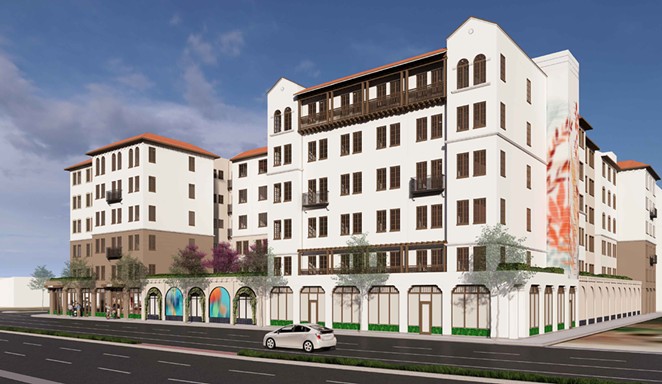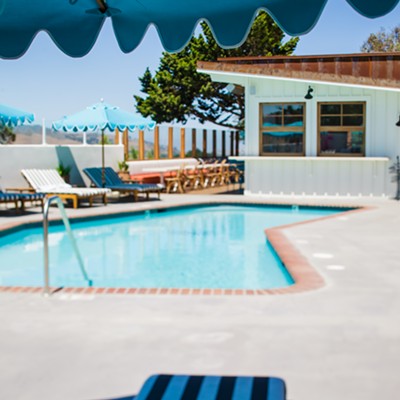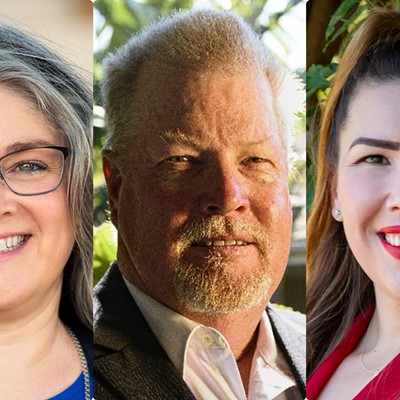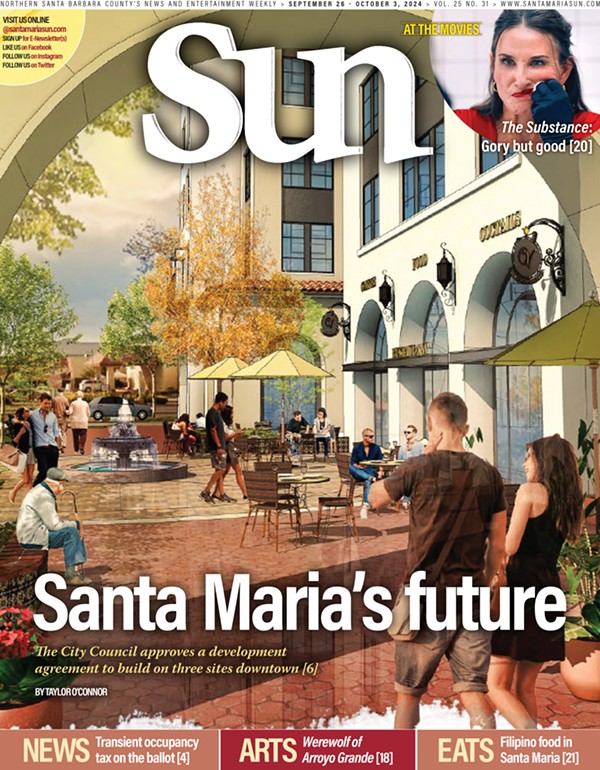Maya Restaurant has seen every iteration of Santa Maria in its nearly 60 years of business. From its vibrant, charming early years to the vacant lots, Santa Maria has been home to the Paredes family.
“The times are changing, and it’s time we keep up with those times to keep our home thriving,” said Tere Paredes, Maya Restaurant’s third-generation owner.
The city’s about to step into an iteration that’s been promised for years. Santa Maria City Council recently voted 4-1, with 1st District Councilmember Carlos Escobedo dissenting, to approve a disposition and sales agreement with The Vernon Group to purchase and redevelop four city-owned parcels in the Main and Broadway corridor.
“We are delighted with the vote, as it was a significant step toward realizing a vision that began 20 years ago,” Vernon Group Partner David Alpert told the Sun via email. “Buildout of the Downtown Specific Plan area will help transform an underutilized urban core into a vibrant city center that will bolster existing businesses, improve property values, and focus demand in an area with existing infrastructure.”
The Santa Barbara-based developer envisioned a future with paseos, open spaces, vibrant shops, increased city revenue, and bustling pedestrian activity with the help of about 600 housing units built alongside commercial and retail development.
The Vernon Group is set to begin construction on one of its lots as soon as 2025, with remaining lots completed closer to 2029. By 2030, The Vernon Group is projecting cumulative tax revenue and city fees upward of $3 million, and the city will fully recover the $2.3 million in development fee reductions in less than two years.
Maya Restaurant owner Paredes initially worried about parking impacts, but she’s now fully on board with the proposal.
“I know for a fact that it will definitely benefit my restaurant,” she said. “When you have tenants at every corner around you, that’s going to bring in more business. I feel very good about this particular plan and project.”
Others aren’t so sure. With the city selling the lots at $120,000 per parcel and providing a nearly 50 percent discount on mitigation fees made possible through the state’s Surplus Lands Act, Councilmember Escobedo worries about the missed revenue opportunities and whether the project will generate the revenue promised.
“We didn’t talk about the actual costs that this will generate for Santa Maria. The developments don’t pay for itself,” Escobedo said. “We are basically giving away, for a really good discount, prime land in the city of Santa Maria that’s downtown.”
Santa Maria firefighters worry about the projected 1,000-person population increase downtown and the accompanying increased calls for services while the Fire Department faces staffing shortages and a citywide budget deficit.
“What my plea to council was: Not only should you be investing in these projects wherever they may be, but please invest in your services, which includes your employees,” Santa Maria Firefighters Union President Matthew Chircop told the Sun.
Assistant City Manager Chuen Wu said that The Vernon Group will pay about $8.5 million in impact fees—one-time dollars that cover the costs for city services, including about $112,000 for police and $154,000 for fire.
“The agreement was approved with the condition that they pay all of the mitigation fees for police and fire,” Wu said. “The sales tax revenue and property tax revenue we’d receive from the developments pay for ongoing public safety costs, and there is no subsidy for that.”
Impact fees fund future facilities like a fire station or ladder truck, but not staffing costs, Chircop said. Over the past year, the firefighters union has been advocating for wage increases to help with recruitment and retention as development negotiations were ongoing.
“This development is injecting a lot of money into downtown. It’s injecting a lot of houses, a very dense population in the downtown,” Chircop said. “I made it clear three times publicly that the firefighters are not opposed to this project, we just need to be included in the investment in the community.”
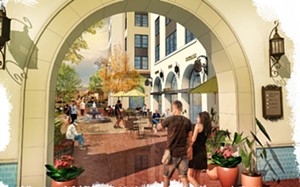
Wu said that The Vernon Group still needs to come back to the Planning Commission and City Council to receive final approval for several of the lots, and the developer has to meet project descriptions, performance measures, and a timing schedule that line up with the overall goals and objectives for downtown.
“I think the way to think about it is it’s a saved redevelopment project. Even though it’s one agreement, not all of the lots will be transferred over at the same time,” Wu said. “It’s one by one, but it’s captured by one agreement. The land doesn’t transfer over to Vernon until they are ready to construct.”
Lot 1 is the parking lot adjacent to the former Fallas/Meryvn’s building on Broadway that will be redeveloped into 375 units of residential condos that will be available for purchase to promote home ownership, Vernon Group Partner Brad Vernon told the City Council during the Sept. 17 meeting. That lot will also have a 150-unit hotel.
Lot 2, the northeast corner of Main and Broadway near Pearlman Park, would provide 160 units of affordable housing, meeting requirements set by the state Surplus Lands Act for private development on city-owned land. The Vernon Group intends for the site to have a gym, employment education center, and low-income services for the community, he said.
Lot 3 will hold a six-story building with a plaza and memorial dedicated to Santa Maria firefighters and Alvin Newton—a firefighter who died during the Bradley Hotel Fire more than 50 years ago—who the apartments will be named for. The City Council already unanimously approved that project, and it will likely be the first project completed.
Lot 4 is a future option that will be discussed after the other projects progress.
Escobedo doesn’t believe that the city will see full cost recovery within The Vernon Group’s projected timeline. He said that no one provided estimates to how much it would cost the city’s general fund and Measure U dollars to add the estimated 1,000 residents that would come through these developments.
“They talked about how people will spend money in Santa Maria—in downtown—but that means people will need services; they are going to need firefighters; there’s going to be more phone calls for services, parks, schools; they’re going to be driving around town so roads will need more attention,” he said. “You need to add all of the costs to the equation, and that was not done.”
Santa Maria can’t afford to be handing out incentives, Escobedo said, and taxpayers shouldn’t be funding private projects, especially during a budget deficit.
“That deficit is part of the reason we are here. … For so many years Santa Maria was giving these incentives,” he said. “This deficit is a consequence to the incentives Santa Maria has been giving for so many years.”
Third District City Councilmember Gloria Soto sees this agreement as cost saving and revenue generating for the city.
“I completely disagree with that notion of, ‘We are in this financial deficit. Let’s not enter into this partnership.’ Let’s flip and say, ‘Do you have $200 million or any investors ready if we said no to Vernon?’” Soto said. “There has been time, money, resources … that have been invested in this project. We could have said no to Vernon, but that downtown corridor would have looked and stayed the same for the next 10 to 20 years.”
When she first joined the City Council, Soto said she recalled people “coalescing” for more housing, retail, and places to go. She said she thinks this is the city’s chance to answer those calls.
“It would have been shortsighted of the council not to approve the project,” she said.
The Vernon Group is investing nearly $200 million into this project—money the city doesn’t have to invest in its corridor, she said. What the city does have is unused land.
“We are not in the business of building housing; we are not in the business of developing commercial properties,” Soto said. “We are a city that’s here to provide services to the residents of Santa Maria and enhance their quality of life.”
Reach Staff Writer Taylor O’Connor at [email protected].


